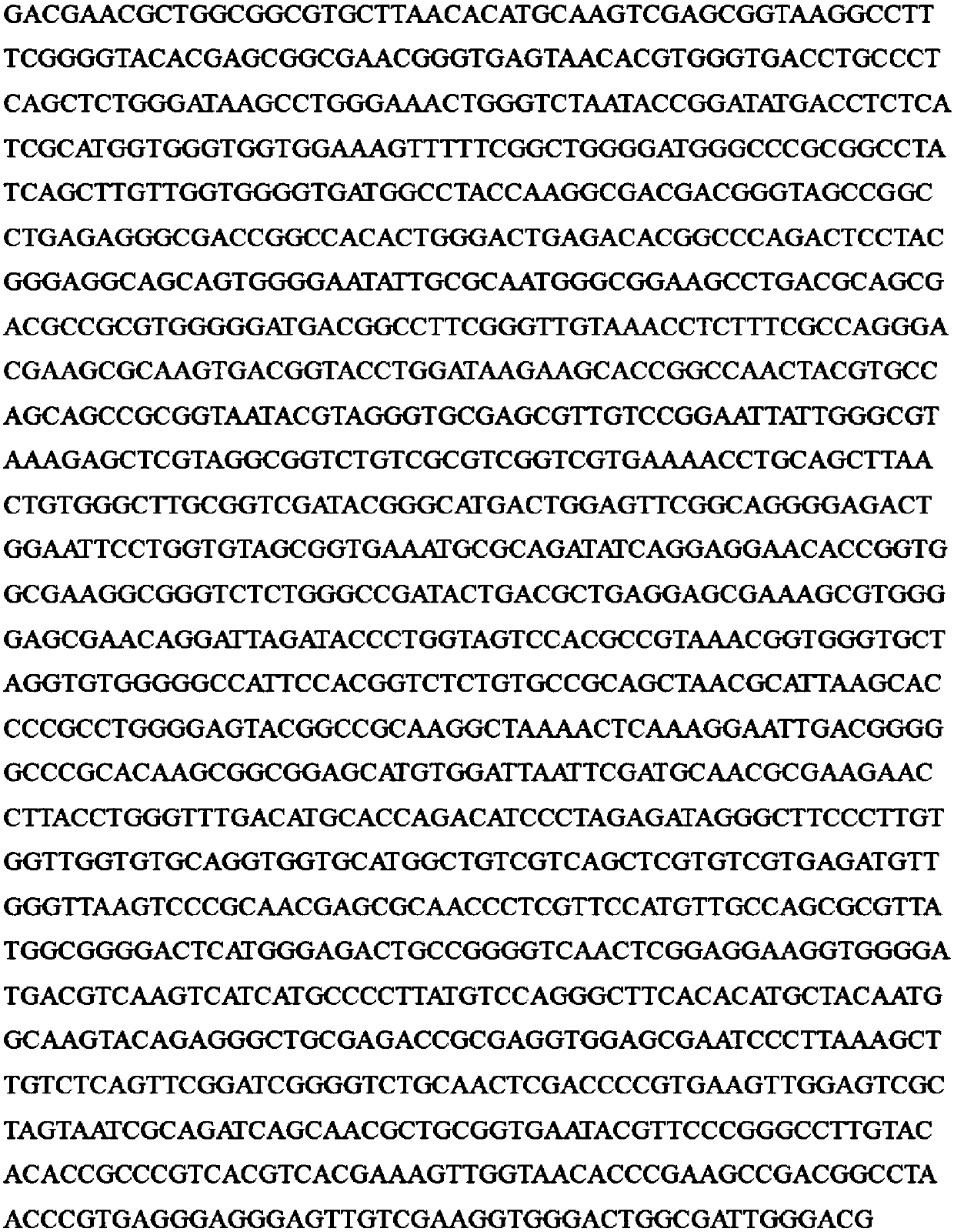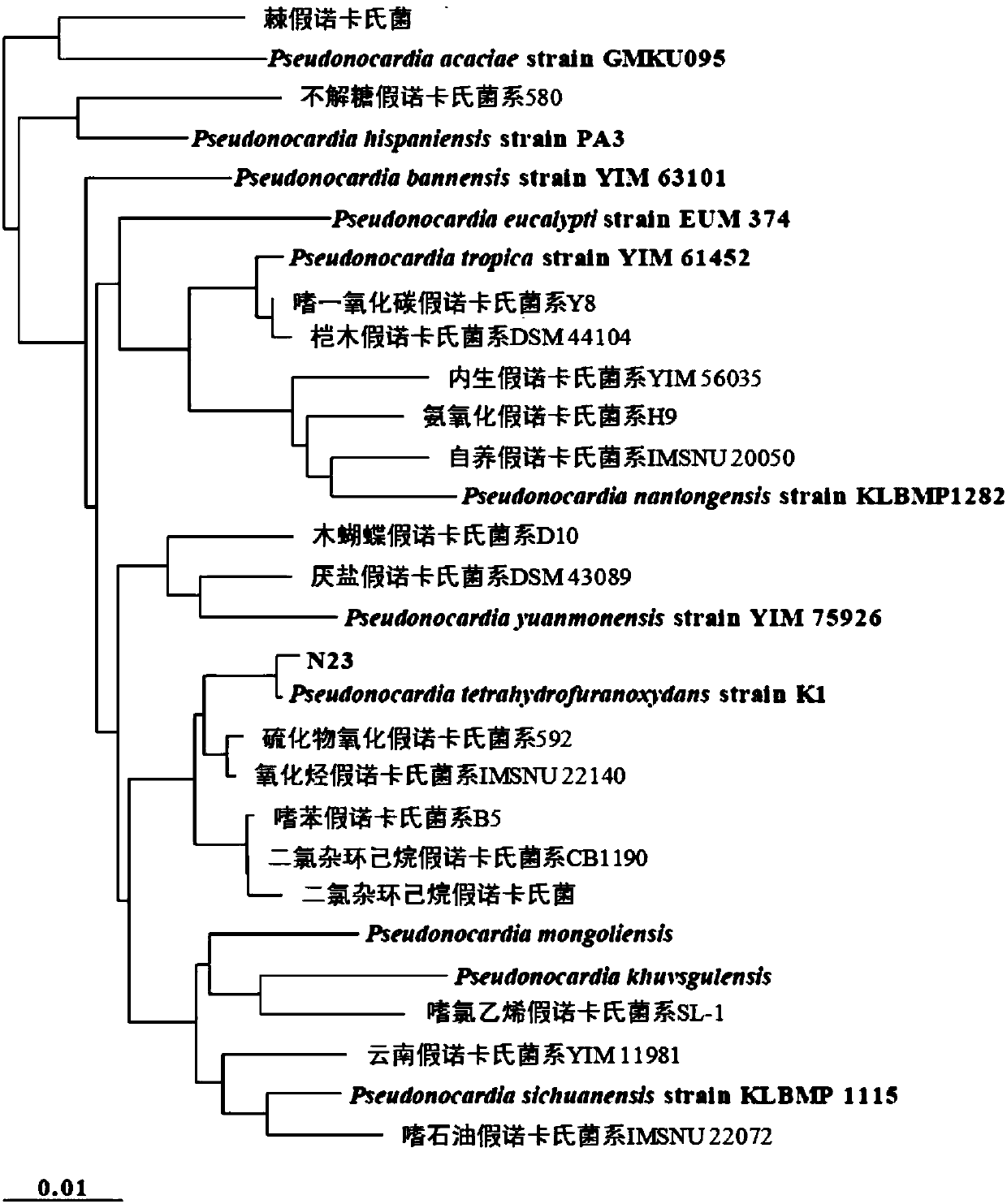Constitutive 1,4-dioxane-degrading bacterium
A dioxane and compositional technology, applied in bacteria, biological water/sewage treatment, organic chemistry, etc., can solve the problem of low specific degradation rate and achieve low-cost effects
- Summary
- Abstract
- Description
- Claims
- Application Information
AI Technical Summary
Problems solved by technology
Method used
Image
Examples
Embodiment 1
[0061] "Determination of the 16S rDNA partial base sequence of the N23 strain"
[0062] The N23 strain was cultured for 7 days (28° C., 120 rpm) in a CGY liquid medium (5 g / L of casetone (Casitone), 5 g / L of glycerol, and 1 g / L of yeast extract). The culture solution was centrifuged at 10,000×g at 4° C. for 3 minutes to collect bacteria, and washed twice with 0.9% physiological saline. From the cleaned cells obtained, according to "Co-translated by Kaoru Saigo and Yumiko Sano: Molecular Biology Experiment Operation Procedure I Adjustment of Bacterial Genomic DNA Basic Operation Procedure Small Adjustment of Bacterial Genomic DNA (miniprep), pp. 36-37, Maruzen Co., Ltd., 1997. "The DNA was extracted, and the PCR amplification of 16S rDNA was performed. As primers, 8F (5'-AGAGTTTGATCCTGGCTCAG-3') and U1492R (5'-GGTTACCTTGTTACGACTT-3') were used. PCR amplification was performed at 94°C for 10 minutes, followed by 35 cycles of denaturation (94°C, 1 minute), annealing (58°C, 1 mi...
Embodiment 2
[0066] "Investigation on the degradation characteristics of 1,4-dioxane of N23 strain"
[0067] Add 100 mL of CGY medium (5 g / L casein, 5 g / L glycerol, 1 g / L yeast extract) to a 300 mL capacity Erlenmeyer shaker flask with baffles, and sterilize in an autoclave (121°C ,15 minutes). After that, 1,4-dioxane was added to make it 500 mg / L, and the N23 strain was inoculated with bacteria in the amount of one inoculated loop, and subjected to rotary shaking culture (28°C, 120rmp) for 7 days (pre-pre-culture ).
[0068] After the culture, subculture was carried out in a CGY medium containing 500 mg / L of 1,4-dioxane, and culture was carried out under the same conditions (pre-culture).
[0069] The culture solution obtained in the pre-cultivation was centrifuged to collect and recover bacteria, and an inorganic salt medium (composition: 1g / L K 2 HPO 4 , 1g / L (NH 4 ) 2 SO 4 , 50mg / L NaCl, 200mg / L MgSO 4 ·7H 2 O, 10mg / L FeCl 3 , 50mg / LCaCl 2 , pH: 7.3) to clean the bacteria. ...
Embodiment 3
[0074] "Confirmation of proliferation of N23 strain by 1,4-dioxane"
[0075] After adding 1 mL of the N23 strain bacterial inoculum prepared in Example 2 to 19 mL of inorganic salt medium, 1,4-dioxane was added to make it a predetermined concentration, and rotation shaking culture was carried out at 28° C. and 120 rpm (n = 3). The culture was carried out for 6 hours, and the 1,4-dioxane concentration before and after the culture was measured by headspace GC / MS, and the protein concentration was measured by the method shown in Example 2. The ratio of the increased protein amount to the amount of 1,4-dioxane degradation was calculated as the cell yield. Figure 5 Indicates the relationship between initial 1,4-dioxane concentration and cell yield.
[0076] An increase in the amount of protein was confirmed in all the experimental systems, and it was confirmed that the N23 strain propagated using 1,4-dioxane as a carbon source. In particular, in the experimental system with an ...
PUM
 Login to View More
Login to View More Abstract
Description
Claims
Application Information
 Login to View More
Login to View More - R&D Engineer
- R&D Manager
- IP Professional
- Industry Leading Data Capabilities
- Powerful AI technology
- Patent DNA Extraction
Browse by: Latest US Patents, China's latest patents, Technical Efficacy Thesaurus, Application Domain, Technology Topic, Popular Technical Reports.
© 2024 PatSnap. All rights reserved.Legal|Privacy policy|Modern Slavery Act Transparency Statement|Sitemap|About US| Contact US: help@patsnap.com










